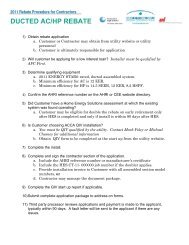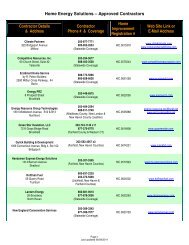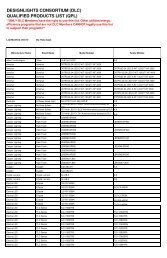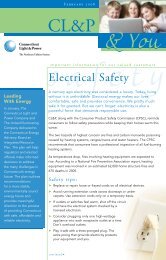here - Northeast Utilities
here - Northeast Utilities
here - Northeast Utilities
Create successful ePaper yourself
Turn your PDF publications into a flip-book with our unique Google optimized e-Paper software.
RESULTS OF CL&P PLAN-IT WISE ENERGY PILOT<br />
Page 4 of 11<br />
Docket No. 05-10-03RE01<br />
Compliance<br />
Order No. 4<br />
customers in the active Pilot distributed equally among the rate, pricing and technology options, plus 200<br />
customers in the control groups. For every 100 customers solicited to join the Pilot, 3.1 percent of<br />
Residential and 4.5 percent C&I customers enrolled. At the close of the rate Pilot 2,437 total customers<br />
were enrolled in the rate Pilot with representation from 1,251 Residential and 1,186 C&I customers, plus<br />
200 control group customers.<br />
The active Pilot period occurred from June 1, 2009 through August 31, 2009. Residential customers had<br />
significantly stronger responses to dynamic pricing rates than C&I customers. Rates in effect for the<br />
fewest number of hours, i.e., the “peakiest rates”, with the higher price differentials were most effective in<br />
reducing peak load. CPP was most effective, followed by the PTR and last, the TOU rate.<br />
In support of the rate response, controlling technologies like the smart thermostats and smart switches<br />
were effective in achieving up to 7 percent additional peak energy usage reduction for Residential<br />
customers and up to 4 percent for C&I customers. However, non-controlling, informational devices like<br />
the Energy Orb and the Power Cost Monitor had no statistical peak energy usage reduction effect.<br />
The higher price differential results for each Pilot rate tested are presented <strong>here</strong>:<br />
• CPP customers who had assistance from controlling technologies achieved a peak usage reduction of<br />
23.3 percent for Residential and 7.2 percent for C&I customers. Customers on the CPP rate alone<br />
(without controlling technologies) achieved a peak usage reduction of 16.1 percent for Residential<br />
customers and 2.8 percent for C&I customers. In contrast to the reduction in peak usage, total energy<br />
usage actually increased by 0.2 percent for Residential customers, but did not change for C&I<br />
customers.<br />
• Customers on the PTR also showed a strong response. Residential customers saw a peak reduction of<br />
17.8 percent when coupled with controlling technologies and 10.9 percent without controlling<br />
technologies. PTR was not as effective for C&I customers, as those customers yielded only a 4.1<br />
percent reduction in peak usage with controlling technologies, but zero statistical impact with the rate<br />
alone. Total energy usage was reduced by 0.2 percent for Residential customers and did not change<br />
for C&I customers.<br />
• The eight-hour TOU rate was the least effective rate. Residential customers reduced their peak<br />
energy usage by 3.1 percent and reduced their total energy use by 0.1 percent. The peak load<br />
reduction from the TOU rate was not affected with the use of controlling technologies. The eighthour<br />
TOU rate was also ineffective for C&I customers, who had zero statistical peak load reduction<br />
and zero statistical decrease in total energy usage, with or without the enabling technologies.<br />
Summer 2009 was a mild summer in the CL&P territory compared to an average. An analysis the pilot<br />
data determined that the CL&P customer response increased with hotter, more humid peak events<br />
compared to milder peak events. Fortunately, the data captured through the Pilot enables the Company to<br />
model the customer price response based on the temperature and humidity. Going forward, the Company<br />
will now be able to forecast price response under hotter, more “normal”, CL&P summer peak days.<br />
Across all rates and on average, Residential customers saved $15.21 and low, including limited income<br />
customers saved $8.07, while C&I customers incurred an additional $15.45. Interestingly, both C&I and<br />
Residential customers who logged on to the web site saved more than customers who did not. C&I<br />
customers who logged on to the web site saved $.14 and Residential customers saved $24.69.<br />
According to post-pilot survey results, most customers were satisfied with the Pilot. Ninety two percent<br />
of Residential and 74 percent of C&I customers would participate again. Residential customers rated<br />
their overall satisfaction of the program at 5.1 out of 6, while C&I customers rated, their satisfaction a 4.1










